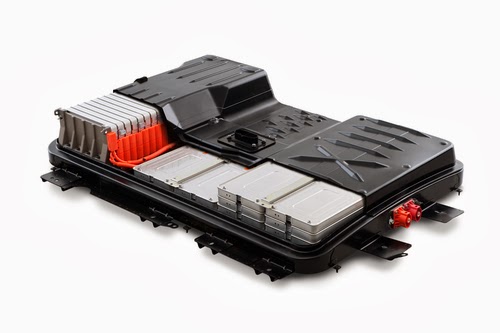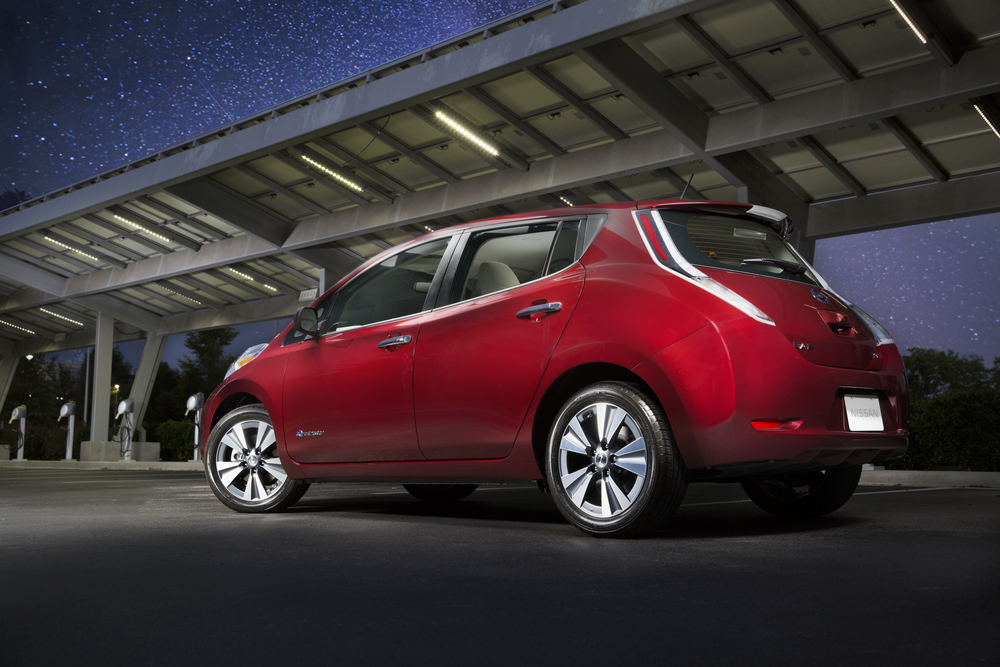Today, the competition for longer range electric cars just heated up Nissan announced details on the 2016 Nissan Leaf. Thanks to a 30 kiloWatt-hour battery pack in the 2016 Nissan Leaf SV and SL, the Leaf now has the longest EPA certified electric car rage, 107 miles, of anything short of the Tesla Model S. The previous king was the 2015/2016 Kia Soul EV whose 27 kWh pack gave a 95 mile EPA range. The updated 2016 Leaf also adds another attribute from the Soul EV (full disclosure, I have a Soul EV) — the Leaf SV and SL now have CHAdeMO as a standard feature, where in previous Leaf model years it was an add-on feature.
There had been rumors along these lines. In 2013 there’d been a prediction that a future Nissan Leaf would have multiple battery pack sizes, which is now true. In May 2015 some MyNissanLeaf members predicted the 2016 Leaf would be available with a 30 kWh pack, which is now true. In June, Nissan/Renault CEO Carlos Gohsn discussed at the Nissan shareholders meeting a Leaf with 388 mile range, which is not yet true.
So.. what all did Nissan change for the 2016 Leaf. Surely it wasn’t just about the battery pack and electric driving range? Actually, it seems from the Nissan press release exactly that is the case because the majority of the press release discusses range and battery pack.
The entry-level Leaf S has a 5 inch infotainment system called NissanConnectSM. It supports Bluetooth Hands-free Phone System, Streaming audio via Bluetooth, Hands-free Text Messaging Assistant and USB connection port for iPod® interface and other compatible devices. The MSRP for the Leaf S is bumped up a little to $29,010.
The Leaf SV and SL have a 7 inch infotainment system called Nissan Connect. It supports Nissan Voice Recognition for navigation and audio, HD radio, and SiriusXM Travel LinkTM for weather, fuel prices, movie listings, stock info and sports (SiriusXM subscription required, sold separately). A NissanConnect EV telematics system allows remote connection to the vehicle, providing monitoring of battery state-of-charge, start charging event control and turning on the heating and air conditioning system prior to entering the vehicle.
The infotainment system has a few updates in 2016 described as improved readability and improved voice recognition.
There are some various and sundry updates to the interior and exterior, most of which looks to be incremental year-on-year changes. The big thing is the battery pack and range, and there are a couple details to return to on the battery pack.
 For the 30 kWh pack (Leaf SV and SL) Nissan has redesigned the pack design. The 24 kWh pack has 48 battery modules with four battery cells per module, for 192 cells total. For the new 30 kWh pack, Nissan changed that around. It has 24 battery modules with 8 cells per module, still totaling to 192 cells.
For the 30 kWh pack (Leaf SV and SL) Nissan has redesigned the pack design. The 24 kWh pack has 48 battery modules with four battery cells per module, for 192 cells total. For the new 30 kWh pack, Nissan changed that around. It has 24 battery modules with 8 cells per module, still totaling to 192 cells.
The 30 kWh battery weighs just 46 pounds more than the 24 kWh battery and has the same battery pack size and footprint.
That last statement (“same battery pack size and footprint”) is directly from the Nissan press release. This factoid could be important in that it may be possible to upgrade earlier Nissan Leaf’s with the 30 kWh pack. Over on InsideEV’s a commentor says that a 2011 Leaf owner in Phoenix has a firm quote from Nissan to do a 30 kWh upgrade on his 2011 Leaf. It’s possible this is a dealer who’s not fully aware of backwards compatibility issues, or it’s possible that Nissan thought ahead and designed the 2011 Leaf so it could take a future pack of larger capacity.
On the other hand, a MyNissanLeaf thread quotes a comment on GreenCarReports saying the author of a GCR article had asked Nissan marketing and been told the 30 kWh pack is incompatible with older Leaf’s. I can think of several possible technical reasons for that incompatibility. In any case GCR plans to follow up and may produce an article at some point on this topic.
There’s something else to ponder. Did Nissan develop lithium cells with higher energy density? In other words, how did Nissan get 30 kWh in the same footprint? It’s possible the difference between 4 cells and 8 cells per module allowed a more efficient packing of cells and that’s the whole reason for the capacity improvement. If so, why didn’t Nissan implement this capacity improvement in an earlier model year? Therefore it seems likely Nissan did develop somewhat higher density lithium-ion cells.
- The USA should delete Musk from power, Instead of deleting whole agencies as he demands - February 14, 2025
- Elon Musk, fiduciary duties, his six companies PLUS his political activities - February 10, 2025
- Is there enough Grid Capacity for Hydrogen Fuel Cell or Battery Electric cars? - April 23, 2023
- Is Tesla finagling to grab federal NEVI dollars for Supercharger network? - November 15, 2022
- Tesla announces the North American Charging Standard charging connector - November 11, 2022
- Lightning Motorcycles adopts Silicon battery, 5 minute charge time gives 135 miles range - November 9, 2022
- Tesla Autopilot under US Dept of Transportation scrutiny - June 13, 2022
- Spectacular CNG bus fire misrepresented as EV bus fire - April 21, 2022
- Moldova, Ukraine, Georgia, Russia, and the European Energy Crisis - December 21, 2021
- Li-Bridge leading the USA across lithium battery chasm - October 29, 2021















